Crete Landmarks and Monuments
(Crete, Greece)
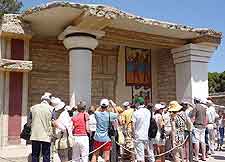
Famous throughout Greece and beyond for its ancient history and Minoan landmarks, there is so much more to Crete that just some nice beaches and lots of sunshine. Knossos stands out as being the most noteworthy of all Crete's Minoan sites and contains a number of important archaeological landmarks, within the remains of its 'Palace of Knossos'.
Further Minoan sites and remains can be found within the ancient settlements of Agia Triada, Gortyna, Gournia, Malia and Phaestos. Other landmarks on Crete include the Ancient City of Aptera, the Lebena Ruins, the Koules Venetian Fortress, the Rethymno Fortress and the Hania fortifications, amongst main other impressive sites.
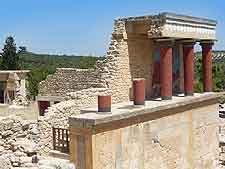
Knossos and other Minoan Sites
Many of the most famous and spectacular archeological sites on Crete are Minoan and few come more impressive than those remaining landmarks within Knossos. Once the Minoan capital of Crete, Knossos is a mere 5 km / 3 miles from Iraklio and is without question the number one attraction, being flooded with tourists all through the year. Within Knossos are the remains of an immense palace complex, where it is said the King Minos once kept his mythical Minotaur creature. Highlights within the Palace of Knossos include the Western Court, the Corridor of the Procession Fresco, the Theatral Area, the Bull Fresco, the Throne Room, the Grand Staircase, the Hall of the Double Axes, and the Queen's Megaron. Other famous ancient Minoan sites and landmarks on Crete include:
- Agia Triada (Hagia Triada) - located on a dramatic coastal ridge, above the Mesara Plain and near to Phaestos
- Gortyna - on the plain of Mesara and just 15 km / 8 miles from Phaestos, highlights include some enormous stone tables which are inscribed with the Laws of Gortyna
- Gournia - home to an especially important Minoan site, located around 18 km / 11 miles to the south-east of Agios Nikolaos, and dating from 1550 BC
- Kamilari - the site of Crete's famous circular Minoan Tomb, which was built in 1900 BC and is extremely well preserved
- Kato Zakros - a small but scenic Minoan settlement, around 7 km / 4 miles from the beach of Kato Zakros
- Malia - with the spectacular remains of the Palace of Malia, first excavated by Crete archaeologists just under 100 years ago
- Phaestos (Phaistos) - the site of the second-most important Minoan palace city on Crete, after Knossos. Phaestos is located roughly 60 km / 37 miles from Iraklio
- Zakros - once a thriving port and featuring the smallest of the island's four Minoan palace complexes, the Palace of Zakros
Open hours: daily, seasonal variations
Admission: charge for some sites
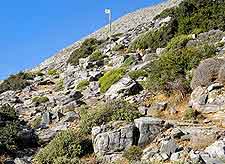
Mount Psiloritis (Idi)
Address: Mount Psiloritis, Crete, Greece, GR
One of the most imposing and impressive of all the landmarks on the island of Crete, Mount Psiloritis also goes by the name of Mount Idi and dominates the entire Amari province, towering almost 2,500 metres / 8,200 feet high. The Nida Plateau forms the eastern base of the mountain and is a huge expanse, encircled by a number of additional, smaller mountains. A paved roads leads to the plateau from Anogia and if you drive along this road, look out for the stone shepherd's huts, which are known locally in Greece as 'mitatas'. Of particular interest, Mount Psiloritis is home to the Ideon Cave, which legend says, is where the Greek god Zeus, king of all the gods, was actually reared.
Open hours: daily
Admission: free
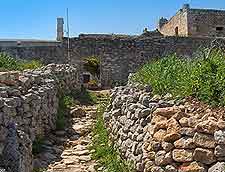
Ancient City of Aptera
Address: West of Kalyves, Crete, Greece, GR
The remains of the ancient city of Aptera are well worth searching out and lie some 3 km / 2 miles directly to the west of Kalyves. These ruins are roughly spread around two large hills, next to the Souda Bay, and date as far back as the 7th century BC, almost 3,000 years. Once one of Crete's most important cities, Aptera was sadly completely destroyed during a major earthquake disaster in the 7th century AD, although was somewhat rebuilt during the 10th century. Today, Aptera is still being meticulously excavated and features some very well-preserved structures, including a Greek temple from the 2nd century BC, Roman cisterns and some gigantic fortified walls. Also here is the considerably younger landmark of a Turkish fortress, constructed in 1872.
Open hours: Tuesday to Sunday - 08:00 to 14:30
Admission: charge
Lebena Ruins
Address: Lendas, Crete, Greece, GR
Located on the very outskirts of the village of Lendas, the archaeological site of Lebena started life as a renowned health spa, using the onsite freshwater springs, which were known for the therapeutic qualities. Very little remains here of the original structures, although there are a couple of large stone columns which were once part of a 4th-century BC temple. There are also some intricately laid mosaic floors which are still clearly visible.
Open hours: daily
Admission: free
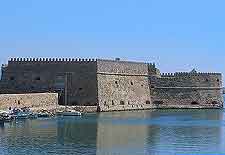
Koules Venetian Fortress (Rocca al Mare)
Address: Iraklio Harbour, Crete, Greece, GR
Built during the 16th century and still dominating the Old Harbour, Crete's Koules Venetian Fortress was known as the Rocca al Mare under the island's Venetian rule. For more than 20 years, this fortress helped to defend the island from Turkish attacks, before actually becoming a Turkish prison for rebelling Cretans. The facade is especially eye-catching and features a number of reliefs depicting the Lion of St. Mark. Step inside the Koules Venetian Fortress to discover more than 20 different restored rooms, a number of which are now used as art galleries.
Open hours: Tuesday to Sunday - 09:00 to 8:00
Admission: charge
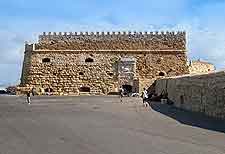
Rethymno Fortress (Fortezza) / Acropolis
Address: Paleokastro Hill, Rethymno, Crete, Greece, GR
Tel: +30 28310 28101
The Rethymno Fortress is located within the lively town of Rethymno and was built during the 16th century. Also the sit of the town's ancient acropolis, the fortress boasts enormous walls, inside of which many different monuments and buildings once stood. All that now remains of these buildings are a church as a rather beautiful mosque. There is plenty to explore as you walk around the ruins, while for the best views, head to the ramparts. An Archaeological Museum is close by and near to the fortress entrance.
Open hours: charge
Admission: June to October, daily - 08:00 to 20:00
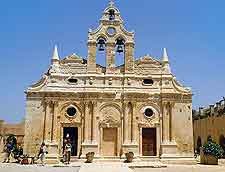
Moni Arkadiou (Monastery)
Address: Arkadi, Crete, Greece, GR
Tel: +30 28310 83138
The 16th-century monastery that is the Moni Arkadiou is to be found just over 22 km / 14 miles to the south-east of Rethymno town. A number of different landmarks are based here, of which the Venetian Baroque-style church is amongst the most impressive, with no less than eight Corinthian columns and a rather special bell tower. Also here is a former windmill, which contains a rather surprising collection of bones and skulls of Turkish soldiers, who attacked in 1866 and lot their lives after Cretans set lit to the monastery's gunpowder store.
Open hours: April to October, daily - 09:00 to 19:00
Admission: charge
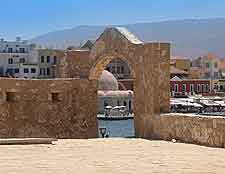
Hania Fortifications (Chania)
Address: Hania, Crete, Greece, GR
Built by the Venetians to protect Hania from possible siege, these awesome medieval fortifications remain one of the city's most noteworthy and visited landmarks. The western wall is the most well-preserved of all the stretches of fortifications still standing and is sandwiches between the Siavo Bastion and the Firkas Fortress. For some excellent views across Hania, head up the Bastion - and bring your camera. Nearby and next to the harbourfront, the Venetian lighthouse may also be worth a look, and is the Mosque of Kioutsouk Hasan.
Great Arsenal
Open hours: daily - 24 hours
Admission: free
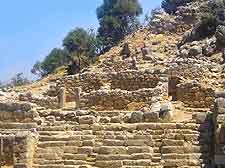
Ancient Lato
Address: Lato, North of Kritsa, Crete, Greece, GR
Standing just 4 km / 2.5 miles to the north of Kritsa, the ancient city of Lato is actually one of the island's few historical sites which is not actually Minoan in origin, being established during the 7th century BC by the Dorians. Lato was a massive Cretan city in its time and led much of the island. Enjoying a truly picturesque mountain setting with views across the Gulf of Mirabello, the main remains within the Lato of today include a theatre, the governing 'pyrataneion' building, various mosaics, and the Temple of Apollo.
Open hours: Tuesday to Sunday - 08:30 to 15:00
Admission: charge
 Famous throughout Greece and beyond for its ancient history and Minoan landmarks, there is so much more to Crete that just some nice beaches and lots of sunshine. Knossos stands out as being the most noteworthy of all Crete's Minoan sites and contains a number of important archaeological landmarks, within the remains of its 'Palace of Knossos'.
Famous throughout Greece and beyond for its ancient history and Minoan landmarks, there is so much more to Crete that just some nice beaches and lots of sunshine. Knossos stands out as being the most noteworthy of all Crete's Minoan sites and contains a number of important archaeological landmarks, within the remains of its 'Palace of Knossos'.






